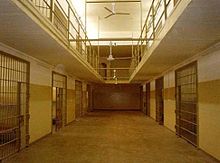

- Red: 600+
- Brown: 400-600
- Orange: 300-400
- Yellow: 200-300
- Lime: 150-200
- Green: 100-150
- Dark Green: 50-100
- Blue: under 50
- Grey: No data
A prison, also known as a correctional facility, jail, gaol (dated, British English), penitentiary (American English), detention center (American English), or remand center is a facility in which inmates are forcibly confined and denied a variety of freedoms under the authority of the state. Prisons are most commonly used within a criminal justice system: people charged with crimes may be imprisoned until they are brought to trial; those pleading or being found guilty of crimes at trial may be sentenced to a specified period of imprisonment.
Prisons can also be used as a tool of political repression by authoritarian regimes. Their perceived opponents may be imprisoned for political crimes, often without trial or other legal due process; this use is illegal under most forms of international law governing fair administration of justice. In times of war, prisoners of war or detainees may be detained in military prisons or prisoner of war camps, and large groups of civilians might be imprisoned in internment camps.
In American English, prison and jail are usually treated as having separate definitions. The term prison or penitentiary tends to describe institutions that incarcerate people for longer periods of time, such as many years, and are operated by the state or federal governments. The term jail tends to describe institutions for confining people for shorter periods of time (e.g. for shorter sentences or pre-trial detention) and are usually operated by local governments. Outside of North America, prison and jail have the same meaning.
Common slang terms for a prison include: "the pokey", "the slammer", "the clink", "the joint", "the calaboose", "the hoosegow" and "the big house". Slang terms for imprisonment include: "behind bars", "in stir" and "up the river" (a possible reference to Sing Sing).
Contents
History
Ancient times
The use of prisons can be traced back to the rise of the state as a form of social organization. Corresponding with the advent of the state was the development of written language, which enabled the creation of formalized legal codes as official guidelines for society. The best known of these early legal codes is the Code of Hammurabi, written in Babylon around 1750 BC. The penalties for violations of the laws in Hammurabi's Code were almost exclusively centered on the concept of lex talionis ("the law of retaliation"), whereby people were punished as a form of vengeance, often by the victims themselves. This notion of punishment as vengeance or retaliation can also be found in many other legal codes from early civilizations, including the ancient Sumerian codes, the Indian Manama Dharma Astra, the Hermes Trismegistus of Egypt, and the Israelite Mosaic Law.
Some Ancient Greek philosophers, such as Plato, began to develop ideas of using punishment to reform offenders instead of simply using it as retribution. Imprisonment as a penalty was used initially for those who could not afford to pay their fines. Eventually, since impoverished Athenians could not pay their fines, leading to indefinite periods of imprisonment, time limits were set instead. The prison in Ancient Athens was known as the desmoterion ("place of chains").
The Romans were among the first to use prisons as a form of punishment, rather than simply for detention. A variety of existing structures were used to house prisoners, such as metal cages, basements of public buildings, and quarries. One of the most notable Roman prisons was the Mamertine Prison, established around 640 B.C. by Ancus Marcius. The Mamertine Prison was located within a sewer system beneath ancient Rome and contained a large network of dungeons where prisoners were held in squalid conditions, contaminated with human waste. Forced labor on public works projects was also a common form of punishment. In many cases, citizens were sentenced to slavery, often in ergastula (a primitive form of prison where unruly slaves were chained to workbenches and performed hard labor).
Middle Ages to the 17th century
During the Middle Ages in Europe, castles, fortresses, and the basements of public buildings were often used as makeshift prisons. The possession of the right and the capability to imprison citizens, however, granted an air of legitimacy to officials at all levels of government, from kings to regional courts to city councils; and the ability to have someone imprisoned or killed served as a signifier of who in society possessed power or authority over others. Another common punishment was sentencing people to galley slavery, which involved chaining prisoners together in the bottoms of ships and forcing them to row on naval or merchant vessels.
However, the concept of the modern prison largely remained unknown until the early 19th-century. Punishment usually consisted of physical forms of punishment, including capital punishment, mutilation, flagellation (whipping), branding, and non-physical punishments, such as public shaming rituals (like the stocks). From the Middle Ages up to the 16th and 17th centuries in Europe, imprisonment was rarely used as a punishment in its own right, and prisons were mainly to hold those awaiting trial and convicts awaiting punishment.
However, an important innovation at the time was the Bridewell House of Corrections, located at Bridewell Palace in London, which resulted in the building of other houses of correction. These houses held mostly petty offenders, vagrants, and the disorderly local poor. In these facilities, inmates were given jobs, and through prison labor they were taught how to work for a living. By the end of the 17th century, houses of correction were absorbed into local prison facilities under the control of the local justice of the peace.
Modern era
From the late 17th century and during the 18th century, popular resistance to public execution and torture became more widespread both in Europe and in the United States. Particularly under the Bloody Code, with few sentencing alternatives, imposition of the death penalty for petty crimes, such as theft, was proving increasingly unpopular with the public; many jurors were refusing to convict defendants of petty crimes when they knew the defendants would be sentenced to death. Rulers began looking for means to punish and control their subjects in a way that did not cause people to associate them with spectacles of tyrannical and sadistic violence. They developed systems of mass incarceration, often with hard labor, as a solution. The prison reform movement that arose at this time was heavily influenced by two somewhat contradictory philosophies. The first was based in Enlightenment ideas of utilitarianism and rationalism, and suggested that prisons should simply be used as a more effective substitute for public corporal punishments such as whipping, hanging, etc. This theory, referred to as deterrence, claims that the primary purpose of prisons is to be so harsh and terrifying that they deter people from committing crimes out of fear of going to prison. The second theory, which saw prisons as a form of rehabilitation or moral reform, was based on religious ideas that equated crime with sin, and saw prisons as a place to instruct prisoners in Christian morality, obedience and proper behavior. These later reformers believed that prisons could be constructed as humane institutions of moral instruction, and that prisoners' behavior could be "corrected" so that when they were released, they would be model members of society.
Transportation, prison ships and penal colonies
England used penal transportation of convicted criminals (and others generally young and poor) for a term of indentured servitude within the general population of British America between the 1610s and 1776. The Transportation Act 1717 made this option available for lesser crimes, or offered it by discretion as a longer-term alternative to the death penalty, which could theoretically be imposed for the growing number of offenses. The substantial expansion of transportation was the first major innovation in eighteenth-century British penal practice. Transportation to America was abruptly suspended by the Criminal Law Act 1776 (16 Geo. 3 c.43) with the start of the American Rebellion. While sentencing to transportation continued, the act instituted a punishment policy of hard labour instead. The suspension of transport also prompted the use of prisons for punishment and the initial start of a prison building program. Britain would resume transportation to specifically planned penal colonies in Australia between 1788 and 1868.
Gaols at the time were run as business ventures, and contained both felons and debtors; the latter were often housed with their wives and younger children. The gaolers made their money by charging the inmates for food, drink, and other services, and the system was generally corruptible. One reform of the seventeenth century was the establishment of the London Bridewell as a house of correction for women and children. It was the first facility to make any medical services available to prisoners.
With the widely used alternative of penal transportation halted in the 1770s, the immediate need for additional penal accommodations emerged. Given the undeveloped institutional facilities, old sailing vessels, termed hulks, were the most readily available and expandable choice to be used as places of temporary confinement. While conditions on these ships were generally appalling, their use and the labor thus provided set a precedent which persuaded many people that mass incarceration and labour were viable methods of crime prevention and punishment. The turn of the 19th century would see the first movement toward Prison reform, and by the 1810s, the first state prisons and correctional facilities were built, thereby inaugurating the modern prison facilities available today.
France also sent criminals to overseas penal colonies, including Louisiana, in the early 18th century. Penal colonies in French Guiana operated until 1952, such as the notable Devil's Island (Île du Diable). Katorga prisons were harsh work camps established in the 17th century in Russia, in remote underpopulated areas of Siberia and the Russian Far East, that had few towns or food sources. Siberia quickly gained its fearful connotation of punishment.
Prison reform movement

Request Movie Now
Watch movie Jail online on Amazon
Watch movie Jail online
Watch The Movie On PrimeMarte Dam Tak Full HD Movie Download

Salakhen (1975) Full HD Movie Download
.jpg)
Coolie Full HD Movie Download

Badla Full HD Movie Download

Love 86 Full HD Movie Download

Meharbani (1982) Full HD Movie Download
.jpg)
Michael Madana Kamarajan Full HD Movie Download

Marigold: An Adventure in India Full HD Movie Download

Reporter Raju Full HD Movie Download

Chamatkar Full HD Movie Download

Devta Full HD Movie Download

Heer Ranjha (1970) Full HD Movie Download
.jpg)
Shaitan Mantrik Full HD Movie Download

Rudhra Kali Full HD Movie Download

Shiv Senapati-The Warrior Full HD Movie Download

The Departed Full HD Movie Download

Lakshami Narasima Full HD Movie Download

Kshana Kshanam Full HD Movie Download

Ayyappa Swamy Mahathyam Full HD Movie Download

Killar Jhansi Full HD Movie Download

Japanil Kalyanaraman Full HD Movie Download

Download latest Movie from bollywood
- 1> baaghi 3
- 2> THE SKY IS PINK MOVIE FULL STORY AND REVIEW
- 3> Luka Chuppi
- 4> TO ALL THE BOYS I’VE LOVED BEFORE
- 5> Kabir Singh
- 6> Street Dancer 3D
- 7> Simmba
- 8> Gone Girl
- 9> The Girl Who Lived
- 10> Ludo
- 11> DILWALE DULHANIA LE JAYENGE
- 12> GUILTY
- 13> The Godfather
- 14> Adventures of Rusty
- 15> Sooryavanshi
- 16> Satyameva Jayate 2
- 17> Thappad
- 18> Bhool Bhulaiyaa 2
- 19> KGFChapter 2
- 20> Mardaani 2
- 21> Pinjar
- 22> Shivaji maharaj
- 23> Ek Villian 2
- 24> Hungama 2
- 25> Divergent
- 26> Mumbai Saga
- 27> The Internship
- 28> HIT (telugu)
- 29> Panga
- 30> The perfect date
- 31> 16 December
- 32> Gopala Gopala (Telugu)
- 33> Brahmastra
- 34> Gangubai Kathiawadi
- 35> Manmadhudu
- 36> Nenu local
- 37> Mahanati
- 38> Shatamanam bavathi
- 39> Lagaan
- 40> After
- 41> MOM
- 42> Shamshera
- 43> Raguvaran BTech
- 44> Khakee
- 45> The villain
- 46> OM
- 47> Mr. perfect
- 48> Bueatifull mind
- 49> Hichki
- 50> Gabbar Singh
- 51> Jogi
- 52> Before Sunrise
- 53> Before Sunset
- 54> Before Midnight
- 55> The Big Bull
- 56> Top Gun: Maverick
- 57> The Purge
- 58> The Sky is Pink
- 59> Laxmmi Bomb
- 60> Sadak 2
- 61> Sufna
- 62> Prithviraj
- 63> PK
- 64> Coolie No 1(2020)
- 65> Black Widow
- 66> Dear Zindagi
- 67> Dil Bechara
- 68> PHIR HERA PHERI
- 69> WAR
- 70> Dostana
- 71> RRR: Roudram Ranam Rudhiram
- 72> Maidan
- 73> Dabbang 3
- 74> Chhalaang
- 75> life as we know it
- 76> SherShaah
- 77> Sandeep Aur Pinky Faraar
- 78> Event Horizon
- 79> 83
- 80> Radhe: Your Most Wanted Bhai
- 81> Gunjan Saxena: The Kargil Girl
- 82> Mr India
- 83> Vivah
- 84> Anokha Bandhan
- 85> Ghost
- 86> Bhoot: Part One - The Haunted Ship
- 87> Haseen Dilruba
- 88> Laal Singh Chaddha
- 89> Qismat
- 90> Rajput
- 91> Drive
- 92> Dil Chahta Hai
- 93> Dil Ki Baazi
- 94> Dil Ka Rishta
- 95> Teesri Manzil
- 96> Dil
- 97> Love Aaj Kal
- 98> Khaali Peeli
- 99> Bunty Aur Babli 2
- 100> Atrangi Re
- 101> Gulabo Sitabo
- 102> Jodi
- 103> Suraj Pe Mangal Bhari
- 104> Deewana
- 105> Attack
- 106> Sardar Udham Singh
- 107> Toofan
- 108> THE LOVEBIRDS
- 109> Jersey
- 110> Ginny Weds Sunny
- 111> Thalaivi
- 112> Shiddat
- 113> Angels vs Zombies
- 114> Koi Mil Gya
- 115> Thank God
- 116> Bhuj: The Pride of India
- 117> Hum Aapke Hain Kaun
- 118> The Platform
- 119> Bird Box
- 120> Roohi Afzana
- 121> Torbaaz
- 122> Nikamma
- 123> World War Z
- 124> Extraction
- 125> Train to Busan
- 126> Life of Pi
- 127> SHAADI MEIN JROOR AANA
- 128> Himmat Aur Mehnat
- 129> To All The Boys: P.S. I Still Love You
- 130> Mimi
- 131> Good Newwz
- 132> Shubh Mangal Zyada Saavdhan
- 133> Raabta
- 134> Harry Potter and the Philosopher's Stone
- 135> Harry Potter and the Chamber of Secrets
- 136> Chhapaak
- 137> War of the Worlds
- 138> Harry Potter and the Prisoner of Azkaban
- 139> Harry Potter and the Goblet of Fire
- 140> MURDER MYSTERY
- 141> Shakuntala Devi
- 142> Bachchan Pandey
- 143> Jayeshbhai Jordar
- 144> Sheer Qorma
- 145> Saina
- 146> 'O' Pushpa I hate tears
- 147> Kedarnath
- 148> MS Dhoni The Untold Story
- 149> Chhichhore
- 150> Badhaai Ho
- 151> Unstoppable
- 152> Oz the Great And Powerful
- 153> The Girl on the Train
- 154> Haathi Mere Saathi 2020
- 155> The Conjuring: The Devil Made Me Do It
- 156> Gandhi Se Pehle Gandhi
- 157> The Song of Scorpions
- 158> Srimanthudu
- 159> Hello Guru Prema Kosame
- 160> Beauty and The Beast
- 161> Black Panther
- 162> Charlie and the Chocolate Factory
- 163> Bole Chudiyan
- 164> Fidaa
- 165> Duvvada Jagannadham
- 166> Bruce Lee: The Fighter
- 167> Hyper
- 168> Yaara
- 169> Red (2020)
- 170> Shivam
- 171> That Is Mahalakshmi
- 172> Nishabdham
- 173> Aashram 2020 web series
- 174> Laxmii
- 175> Mismatched
- 176> STUDENT OF THE YEAR 2
- 177> NAIL POLISH
- 178> Ramprasad Ki Tehrvi
- 179> KAAGAZ
- 180> 12 o Clock
- 181> The Power
- 182> bolo hau
- 183> Tribhanga
- 184> JAMUN
- 185> Madam Chief Minister
- 186> Maasaab
- 187> Aadhaar
- 188> Tanhaji
- 189> Bhaagi 3
- 190> Bhootnath
- 191> MALANG
- 192> Jai Mummy Di
- 193> Haathi Mere Saathi 2021
- 194> Shakeela
- 195> Unpaused
- 196> Annayya
- 197> Vamsoddharakudu
- 198> Mrugaraju
- 199> Narasimha Naidu
- 200> Sankranti
- 201> Manasu Maata Vinadhu
- 202> Anjaane
- 203> Apaharan
- 204> Bachke Rehna Re Baba
- 205> Bewafaa
- 206> Roohi
- 207> Radhe
- 208> Zindagi Khoobsoorat Hai
- 209> Yeh Mohabbat Hai
- 210> Yeh Kya Ho Raha Hai?
- 211> The Tomorrow War
- 212> DehradunDiary
- 213> Meri Shaadi Karaoo
- 214> Matruu Ki Bijlee Ka Mandola
- 215> No One Killed Jesica
- 216> Aag Ka Goola
- 217> Eight Million Dollars
- 218> Three Hundred
- 219> Cats and Dog
- 220> Decoy
- 221> Gold Rush
- 222> You Have Got Mail
- 223> Final Destination three
- 224> Tofan
- 225> Jungle
Request for Download movie Jail
- Bollywood movies
- Latest Bollywood movies
- Download all bengali movies
- Download all bhojpuri movies
- Download all english movies
- Download all gujarati movies
- Download all hindi movies
- Download all kannada movies
- Download all malayalam movies
- Download all marathi movies
- Download all oriya movies
- Download all punjabi movies
- Download all tamil movies
- Download all telugu movies
- Bollywood action movies
- Bollywood adventure movies
- Bollywood animation movies
- Bollywood classical movies
- Bollywood comedy movies
- Bollywood crime movies
- Bollywood devotional movies
- Bollywood documentary movies
- Bollywood drama movies
- Bollywood family movies
- Bollywood fantasy movies
- Bollywood historical movies
- Bollywood history movies
- Bollywood horror movies
- Bollywood musical movies
- Bollywood mystery movies
- Bollywood mythological movies
- Bollywood patriotic movies
- Bollywood romance movies
- Bollywood romantic movies
- Bollywood sci-fi movies
- Bollywood social movies
- Bollywood spiritual movies
- Bollywood sports movies
- Bollywood suspense movies
- Bollywood thriller movies
- Bollywood war movies
- Hot actress list
- Hot gujarati actress list
- Hot tamil actress list
- Hot bhojpuri actress list
- Hot assam actress list
- Hot bihari actress list
- Hot jammu and kashmir actress list
- Hot gujarati actress list
- Hot haryana actress list
- Hot konkani actress list
- Hot marathi actress list
- Hot odia actress list
- Hot punjabi actress list
- Hot rajasthani actress list
- Hot kannada actress list
- Hot malayalam actress list
- Hot telugu actress list
- Hot tulu actress list
- Hot Actress list from Indian city
- Hot actress list from ahmedabad
- Hot actress list from alappuzha
- Hot actress list from bangalore
- Hot actress list from bangalore
- Hot actress list from bhopal
- Hot actress list from chandigarh
- Hot actress list from chennai
- Hot actress list from guwahati
- Hot actress list from hyderabad, india
- Hot actress list from indore
- Hot actress list from jaipur
- Hot actress list from kannur
- Hot actress list from kochi
- Hot actress list from kolkata
- Hot actress list from kollam
- Hot actress list from kottayam
- Hot actress list from kozhikode
- Hot actress list from lucknow
- Hot actress list from madurai
- Hot actress list from mangalore
- Hot actress list from mumbai
- Hot actress list from mysore
- Hot actress list from new delhi
- Hot actress list from patna
- Hot actress list from pune
- Hot actress list from thiruvananthapuram
- Hot actress list from thrissur
- Hot actress list from tiruchirappalli
- Hot actress list from vijayawada
- Hot actress list from visakhapatnam
- All Bollywood Movies
- Bollywood Celeb
- >Art Director
- >Audiography
- >Background Music
- >Banner
- >Choreographer
- >Cinematographer
- >Costume Designer
- >Dialogue Writer
- >Director
- >Distributor
- >Editor
- >Executive Producer
- >Hair Stylist
- >Lyricist
- >Music Director
- >Photographer
- >Playback Singers
- >Presenter
- >Producer
- >Production Company
- >Production Designer
- >Screenplay
- >Singer
- >Sound
- >Actor
- >Story Writer
- >Studio
- >Video Director
- >Miscellaneous
- >Publicity (pro)
- >Web Creator
- >Production Labs
- >Publicity Design
- >Publicity Stills
- >Writer
- >Miscellaneous Artists
- >Visual Effects
- >Reporter
- >Music Company
- >Shooting Studios
- >Picturised On
- >Line Producer
- >Co Producer
- >Asst Director
- >Casting Director
- >Cinematography
- >Choreography
- >Dialouge
- >Editing
- >Lyrics
- >Music
- >Story
- >Playback Singer Female
- >Playback Singer Male
- >Actor In A Comic Role (male/female)
- >Child Artiste
- >Ensemble Cast
- >Actor Popular Choice (male)
- >Actor Popular Choice (female)
- >Sa Re Ga Ma Pa Song Of The Year
- >Actor In Supporting Role
- >Actress In Supporting Role
- >Actor In Leading Role
- >Art Direction
- >Actress In Leading Role
- >Sound Recording
- >Costume Design
- >Special Effects
- >Action
- >Actor In A Negative Role
- >Lifetime Achievement Award
- >Cinematic Exellence (director)
- >Cinematic Exellence (male)
- >Cinematic Exellence (female)
- >International Male Icon
- >International Female Icon
- >Actor In A Supporting Role (male)
- >Actor In A Supporting Role (female)
- >Actor In A Comic Role
- >Playback Singer (male)
- >Playback Singer (female)
- >Most Promising Debut (female)
- >Most Promising Debut (male)
- >Most Promising Director
- >Sound Design
- >Lifetime Jodi
- >Marketed Film
- >Jury Award For Best Actor
- >Jury Award For Best Actress
- >Jury Award For Best Film
- >Jury Award For Best Director
- >Playback Singer(male)
- >Lifetime Acheivement Award (male)
- >Excellence Award
- >Jodi Award
- >Performer Of The Year
- >Presented By